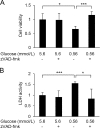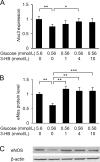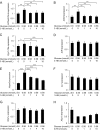Protective effect of 3-hydroxybutyrate against endoplasmic reticulum stress-associated vascular endothelial cell damage induced by low glucose exposure
- PMID: 29554103
- PMCID: PMC5858752
- DOI: 10.1371/journal.pone.0191147
Protective effect of 3-hydroxybutyrate against endoplasmic reticulum stress-associated vascular endothelial cell damage induced by low glucose exposure
Abstract
Aims/hypothesis: The aim of this study was to elucidate the mechanism by which severe hypoglycemia accelerates vascular complications. Furthermore, we assessed the possible protective effect of ketone bodies against the endothelial cell damage caused by glucose deficiency.
Methods: Human umbilical vein endothelial cells (HUVECs) were cultured at a glucose level of either 0.56 or 5.6 mmol/L with or without 3-hydroxybutyrate (3-HB) supplementation. Cell viability was assessed with a CCK-8 assay and a lactate dehydrogenase (LDH) release assay. The activity of caspases was measured using fluorogenic substrates. The expression of genes associated with endothelial cell function and endoplasmic reticulum (ER) stress was evaluated by real-time quantitative PCR. Protein levels of ER stress-related molecules were assessed by Western blotting.
Results: Culture of HUVECs in low-glucose medium for 24 or 48 h resulted in reduction of cell viability accompanied by activation of caspase-3/7 and caspase-8. The addition of a pan caspase inhibitor attenuated the cell death. After incubation in the low-glucose medium, we found reduced mRNA and protein levels of endothelial nitric oxide synthase. ER stress responses mediated by phosphorylation of protein kinase RNA-like ER kinase (PERK) and cleavage of activating transcription factor 6 (ATF6) were augmented, but X-box binding protein 1 (Xbp1) splicing was reduced. Most of these responses to glucose deficiency were significantly attenuated by supplementation with 3-HB.
Conclusions/interpretation: These observations showed that exposure to low glucose induces ER stress, caspase activation, endothelial cell dysfunction and cell death. The beneficial effects of 3-HB shown in this study suggest that hypoketonemic severe hypoglycemia induced by insulin injections or insulin secretagogue administration may be more harmful than hyperketonemic severe hypoglycemia.
Conflict of interest statement
Figures






Similar articles
-
Activation of the endoplasmic reticulum stress response by the amyloid-beta 1-40 peptide in brain endothelial cells.Biochim Biophys Acta. 2013 Dec;1832(12):2191-203. doi: 10.1016/j.bbadis.2013.08.007. Epub 2013 Aug 28. Biochim Biophys Acta. 2013. PMID: 23994613
-
Heme oxygenase (HO)-1 induction prevents Endoplasmic Reticulum stress-mediated endothelial cell death and impaired angiogenic capacity.Biochem Pharmacol. 2017 Mar 1;127:46-59. doi: 10.1016/j.bcp.2016.12.009. Epub 2016 Dec 21. Biochem Pharmacol. 2017. PMID: 28012960
-
[Salidroside attenuates high glucose-induced apoptosis in human umbilical vein endothelial cells via activating the Ca(2)+/CaM/CAMKIIδ/eNOS pathway].Zhonghua Xin Xue Guan Bing Za Zhi. 2014 Apr;42(4):327-33. Zhonghua Xin Xue Guan Bing Za Zhi. 2014. PMID: 24924461 Chinese.
-
Salidroside protects against homocysteine-induced injury in human umbilical vein endothelial cells via the regulation of endoplasmic reticulum stress.Cardiovasc Ther. 2017 Feb;35(1):33-39. doi: 10.1111/1755-5922.12234. Cardiovasc Ther. 2017. PMID: 27809414
-
Madecassic Acid protects against hypoxia-induced oxidative stress in retinal microvascular endothelial cells via ROS-mediated endoplasmic reticulum stress.Biomed Pharmacother. 2016 Dec;84:845-852. doi: 10.1016/j.biopha.2016.10.015. Epub 2016 Oct 8. Biomed Pharmacother. 2016. PMID: 27728894
Cited by
-
Liver circadian clock disruption alters perivascular adipose tissue gene expression and aortic function in mice.Am J Physiol Regul Integr Comp Physiol. 2021 Jun 1;320(6):R960-R971. doi: 10.1152/ajpregu.00128.2020. Epub 2021 Apr 21. Am J Physiol Regul Integr Comp Physiol. 2021. PMID: 33881363 Free PMC article.
-
The proteomic effects of ketone bodies: implications for proteostasis and brain proteinopathies.Front Mol Neurosci. 2023 Jul 27;16:1214092. doi: 10.3389/fnmol.2023.1214092. eCollection 2023. Front Mol Neurosci. 2023. PMID: 37575967 Free PMC article. Review.
-
Ischemic brain injury in diabetes and endoplasmic reticulum stress.Neurochem Int. 2022 Jan;152:105219. doi: 10.1016/j.neuint.2021.105219. Epub 2021 Nov 1. Neurochem Int. 2022. PMID: 34736936 Free PMC article. Review.
-
The potential contribution of impaired brain glucose metabolism to congenital Zika syndrome.J Anat. 2019 Sep;235(3):468-480. doi: 10.1111/joa.12959. Epub 2019 Feb 21. J Anat. 2019. PMID: 30793304 Free PMC article. Review.
-
Induced Ketosis as a Treatment for Neuroprogressive Disorders: Food for Thought?Int J Neuropsychopharmacol. 2020 Jun 24;23(6):366-384. doi: 10.1093/ijnp/pyaa008. Int J Neuropsychopharmacol. 2020. PMID: 32034911 Free PMC article. Review.
References
-
- Goto A, Arah OA, Goto M, Terauchi Y, Noda M. Severe hypoglycaemia and ardiovascular disease: systematic review and meta-analysis with bias analysis. BMJ. 2013;347: f4533 doi: 10.1136/bmj.f4533 - DOI - PubMed
-
- Wright RJ, Frier BM. Vascular disease and diabetes: is hypoglycaemia an aggravating factor? Diabetes Metab Res Rev. 2008;24: 353–63. doi: 10.1002/dmrr.865 - DOI - PubMed
-
- Cryer PE. The barrier of hypoglycemia in diabetes. Diabetes 2008;57:3169–76. doi: 10.2337/db08-1084 - DOI - PMC - PubMed
-
- Davignon J, Ganz P. Role of endothelial dysfunction in atherosclerosis. Circulation. 2004;109: III27–32. doi: 10.1161/01.CIR.0000131515.03336.f8 - DOI - PubMed
MeSH terms
Substances
LinkOut - more resources
Full Text Sources
Other Literature Sources
Research Materials
Miscellaneous

